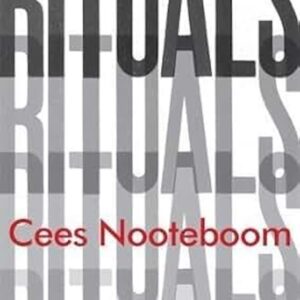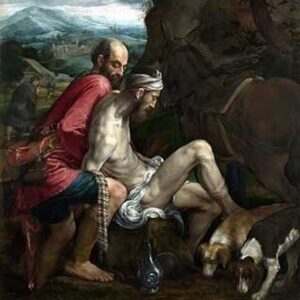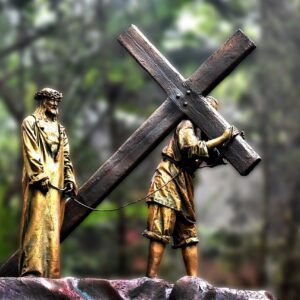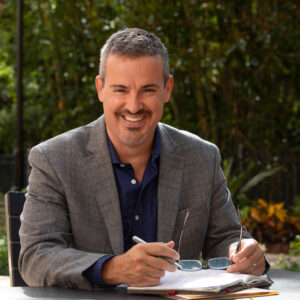Jon Fosse’s novel Septology (published in Norwegian in 2019) is a monologue beginning and ending in the mind of Asle, an elderly widowed Norwegian painter living in the countryside on the proceeds from the sale of his paintings. He communes throughout the next 667 pages with a self who becomes both him and not him.
With his first word, “And,” we seem to break into Asle’s monologue as he begins his day. He proceeds conscientiously, not allowing himself to edit his thoughts according to a prior scheme. The result is a voice that because of its attention to each seemingly minute detail of his thinking process, bears the reader along on its ebb and flow during the day to come:
And I see myself standing and looking at the picture with the two lines that cross in the middle, one purple line, one brown line, it’s a painting wider than it is high and I see that I’ve painted the lines slowly, the paint is thick, two long wide lines, and they’ve dripped, where the blue line and the purple line cross the colours blend beautifully and drip and I’m thinking this isn’t the picture but suddenly the picture is the way it’s supposed to be, it’s done, there’s nothing more to do on it, I think, it’s time to put it away, I don’t want to stand here at the easel anymore, I don’t want to think about it anymore…
This voice continues for the next four pages, passing through what we’ll recognize later as important landmarks in his week-long journey through his thought process (the title Septology could refer to the book’s seven parts, corresponding to the seven days of the week we spend with Asle). Those landmarks include the plan to spend Christmas day at the house of his only friend Asleik’s sister; other plans to bring his finished paintings to Breyer, the owner of a gallery in town where Asle sells his paintings every Advent; and memories of his deceased wife, Ales.
But then Asle’s voice without warning begins to include the thoughts of a different Asle:
… and I fall into the nice stupor you can get into while you’re driving and I realize I’m driving right past the apartment building where Asle lives in Sailor’s Cove, right at the edge of the sea, there’s a little wharf in front of it, I think, and I see Asle lying there on his sofa and he’s shaking, his whole body’s shivering, and Asle thinks can’t this shaking stop?…
The question at this point, for I suppose any reader, is: which is the “real” Asle? The Asle we heard at the beginning? Or this “other” Asle into whose mind we’ve now slipped? The question becomes more and more pressing because, as we advance through the book, we learn that that the “first” Asle resembles the “second” Asle in many ways. Beyond their sharing a first name (no surname is given either of them), both are the same age and dress the same way, both have lived their lives in the same area of Norway, both are painters by profession.
But as we slip back and forth between the two Asles’ thoughts, we discover that their lives have diverged in drastic ways: the narrator Asle turned away from alcohol addiction after he met and married Ales, and under her influence was baptized a Roman Catholic. His success as a painter grew from this point. The other Asle’s two marriages were disastrous and seem to have exacerbated the alcoholism which is destroying him.
Paradoxically, as different as the Asles’ identities become, the more their life stories converge. Yet it’s not just between the two Asles that convergence occurs. Most notable perhaps is the blending between Asle and his wife, Ales. They are inseparable from the moment they meet; and after her death, their inseparability becomes, if possible, even more intimate. The fact that their first names are anagrams reinforces that intimacy in difference.
Convergences, blendings, or paradoxes occur not only between characters. They describe the link between the basic elements of art: form and content. At least they do so for narrator Asle. In this passage towards the end of the book he describes what he hopes his paintings embody:
… and I also don’t believe in what I think in words, I think and I think that it’s only in my pictures, when I’ve painted well, that something can be said, yes, a little something, about what I’ve experienced and what I know, and then it’s said not by the picture itself, not by the colours, the shapes, yes, well, everything that’s in the picture, and also by what the picture represents somehow or another, but only by the picture’s distinct unity of form and content in one, like the spirit, and this spirit, this unity is as invisible as the picture, the painting, is visible, and what the spirit is in reality is this spirit, and that’s what a picture really is, neither matter nor soul but both parts at the same time, and together they make up what I think of as spirit, and that’s why my good paintings, yes, all good paintings, have something to do with what I, what Christians, call the Holy Spirit, because all good art has this spirit, good pictures, good poems, good music…
But if this “unity” between form and content, this “spirit,” is invisible, how can it be talked about? It can’t be, unless one can, through faith, not only tolerate but treasure the paradoxes that result, since all paradoxes in Septology point toward their resolution in unity. That is why, I think, the narrator frequently muses on the bounty of what he cannot understand, even as he dismisses his inevitably imperfect attempts to state what that bounty is.
…and maybe God is closest of all to those who are poor in spirit, those who never think about God, yes, because they shall inherit the kingdom of God, as is written, I think, and it’s always these words, yes, that only have meaning when they contradict each other, and Meister Eckhart has thought of almost everything I think before I did, I think, but isn’t every human being a unity of opposites, yes, a paradox, they call it, coincidencia oppositorum, with a body and a soul, like how Christ was both human and God, yes, Jesus Christ is himself the paradox that contains the paradox that all people are, I think, so that the cross is the symbol of the paradox, I think, and I think that since faith is paradoxical, self-contradictory, they call it, it can never be understood with reason…
The paradoxical spirituality of Septology (its embrace of the coincidencia oppositorum) is, for me, its most powerful feature, since the influence of the coincidencia oppositorum shapes all significant relations within the book. Yet it is, as we’ve seen, an influence that can never be seen, only glimpsed and yearned for, on the further side of our confinements within identity and life itself.
After getting his PhD in English literature, George Dardess taught close reading to his own students until his retirement. Since then he has been ordained a Deacon in the Roman Catholic Church and written several books on Muslim-Christian relations. He has also created the graphic novel Foreign Exchange.





